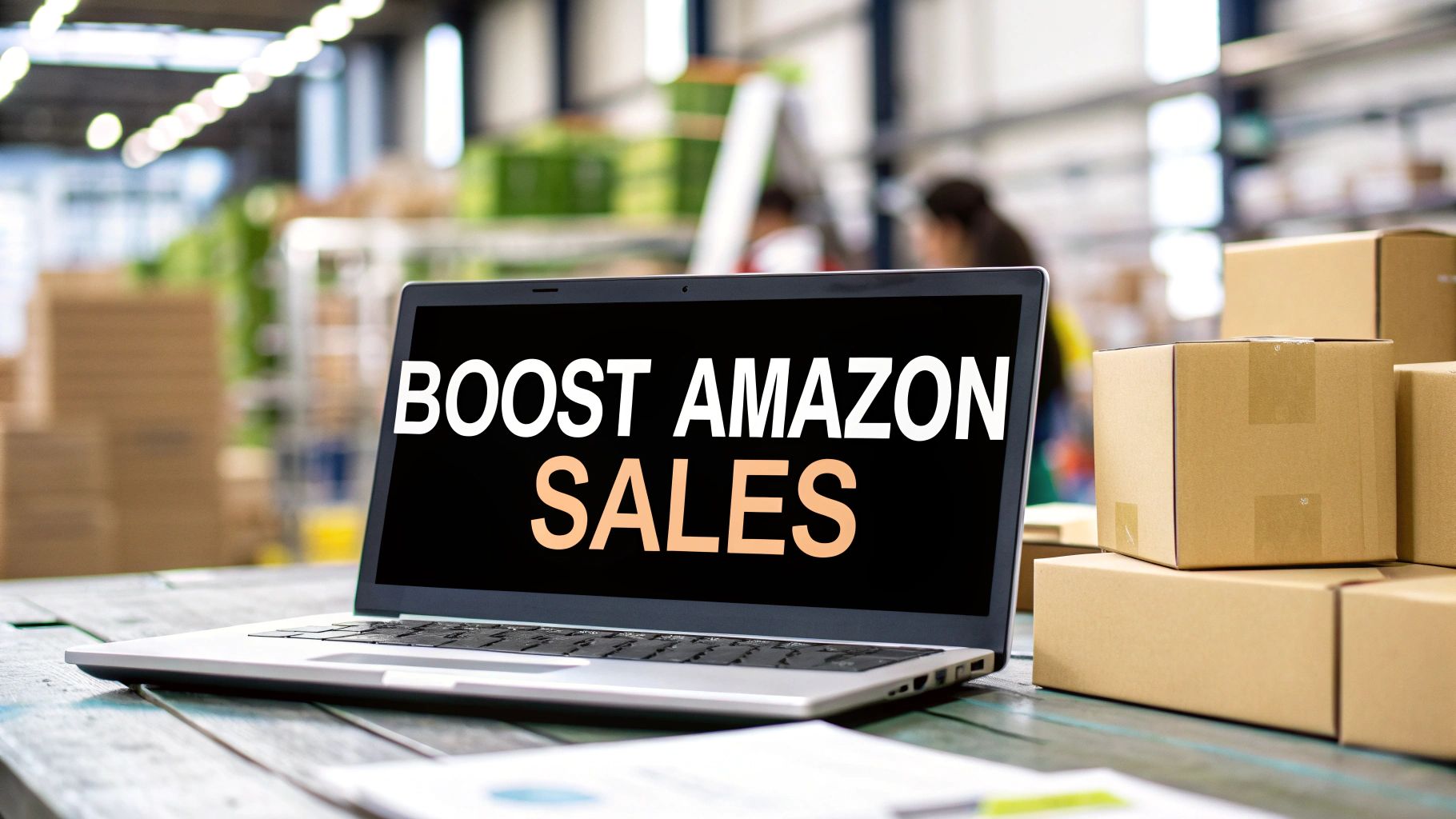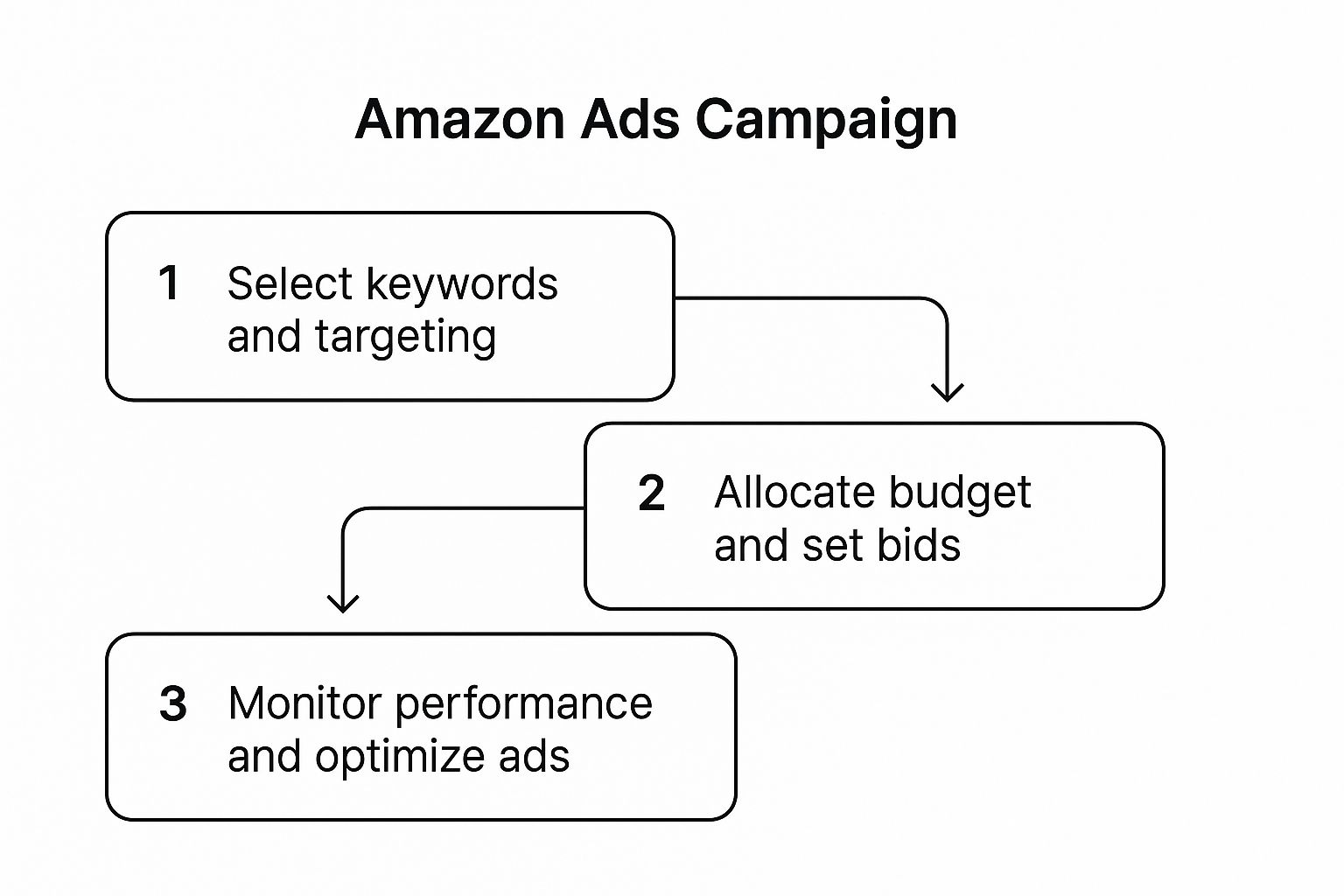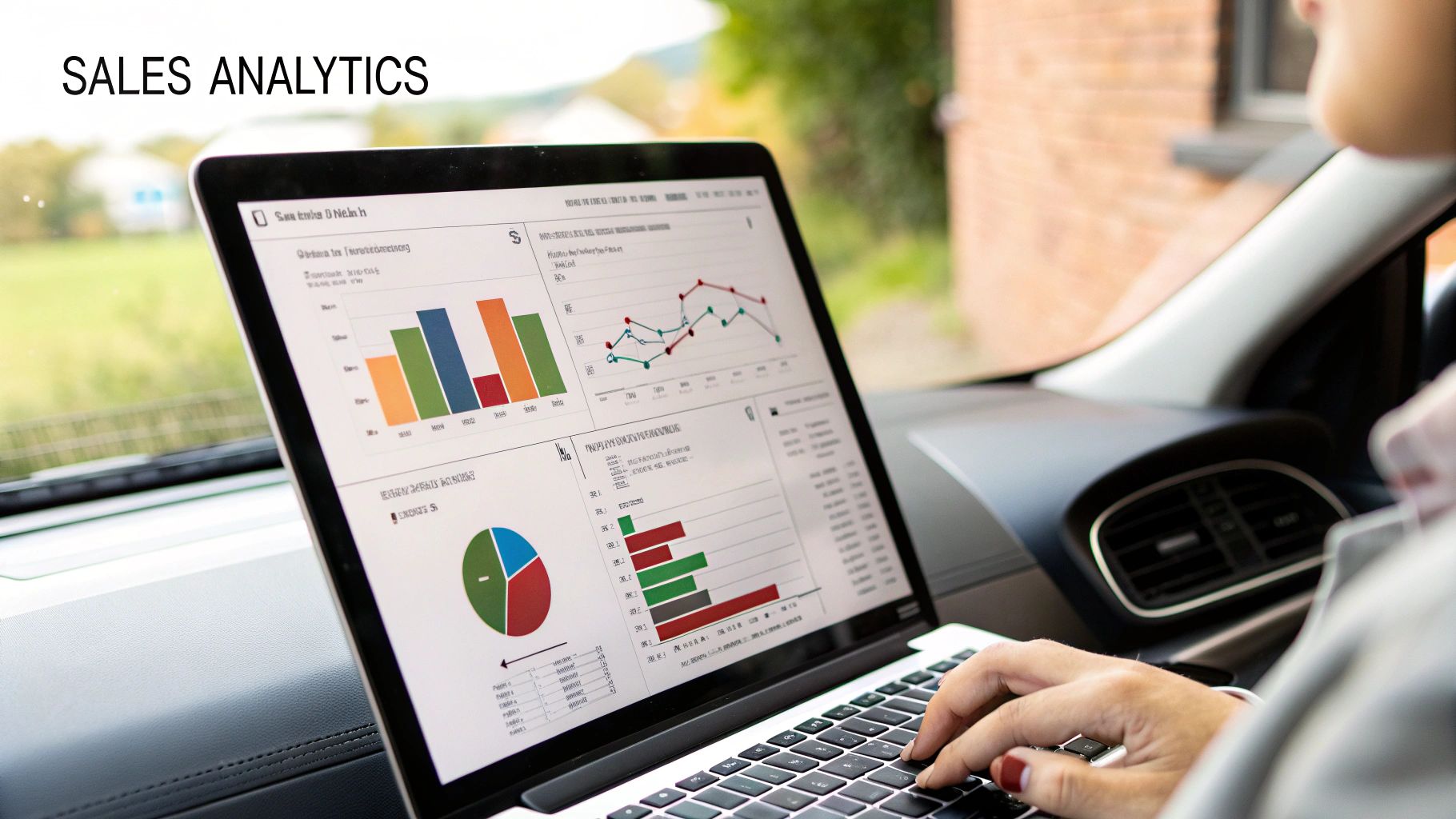Stay Updated with Everything about MDS
Thank you! Your submission has been received!
Oops! Something went wrong while submitting the form.

Chilat Doina
August 24, 2025
Looking to boost your Amazon sales? It's a question every seller asks. The answer isn't a single magic bullet but a smart, multi-pronged strategy that zeroes in on a few key areas: optimizing your product listings for maximum visibility, running targeted ad campaigns that actually reach buyers, and setting sharp pricing to win that coveted Buy Box.
This isn't just about tweaking a few things here and there. It's about building a powerful, interconnected system for growth.

So many sellers get stuck in the weeds, thinking a few keyword updates or a tiny ad budget will magically transform their business. The truth is, sustainable growth on Amazon demands a more thoughtful, holistic approach. You need to create a system where each part of your strategy—from your main image to your customer service—fuels the others, creating a powerful flywheel effect.
This guide cuts through the generic advice to give you a practical, actionable playbook. We're going to break down how to satisfy Amazon's A9 algorithm and connect with the real-world shoppers who make the buying decisions.
To really move the needle on sales, you have to wear two hats: data analyst and brand storyteller. It means diving deep into the metrics that matter while also crafting a compelling narrative that makes customers want to buy your product.
We'll be focusing on the four pillars that are absolutely essential for success:
Success on Amazon is never linear. A perfectly optimized listing won't sell if no one ever sees it. A brilliant ad campaign will just burn cash if it sends traffic to a weak, unconvincing product page.
Every single element plays a role. The strategies in this guide are designed to work in tandem, creating a complete system that can elevate your brand above the noise. For a deeper look at some of these foundational ideas, check out this excellent guide on how to improve Amazon sales.
The real key is to stop treating these as separate tasks and start seeing them as an integrated sales engine. When your listings, ads, pricing, and reviews all align, you create a kind of momentum that becomes incredibly difficult for your competitors to stop.
To give you a clear roadmap, the table below summarizes the core strategies we're about to unpack. Think of it as your cheat sheet for building a more profitable Amazon business.
With this framework in mind, you're ready to start implementing the specific, actionable steps that will make a real difference. Let's dive in.

Think of your product listing as your digital salesperson, working around the clock. Its only job is to turn a casual browser into a buyer. A weak listing is like a silent, unhelpful employee standing in the corner of a store—it’s actively costing you sales every single day.
To really move the needle on Amazon, you have to stop just describing your product and start selling the solution it provides. This means every single element, from the first word in your title to the very last bullet point, has to be crafted with your customer's problems and desires in mind.
On a crowded search results page, your title is your first, and maybe only, shot to make an impression. A killer title does two jobs at once: it feeds Amazon's A9 algorithm with the keywords it needs to see, and it speaks directly to a real person's problem.
Don't just rattle off a list of features. The magic happens when you weave your most important keywords into a headline that screams benefits.
That second title is a world apart. It instantly answers key questions about who it's for, what it does, and where they can use it, making it far more compelling for someone planning their next big trip. This kind of clarity is what drives a higher click-through rate, a massive signal to Amazon's ranking algorithm.
Your bullet points are where you close the deal. Shoppers are scanners, so each point has to land with impact. I’ve found the most effective strategy is to treat every bullet point as an answer to a question the customer hasn't even asked yet.
Get inside their head. They aren't just buying "durable fabric"; they're buying the peace of mind that their gear won't fall apart when they're miles from civilization.
My go-to method is framing each bullet around a "Benefit + Feature" structure. Lead with what the customer actually cares about, then back it up with the specific feature that makes it happen. This simple shift can make a huge difference in your conversion rate.
For example, instead of a flat "Made with Ripstop Nylon," you could write:
See the difference? This format connects directly to a customer’s needs while still packing in the essential keywords.
While many shoppers decide based on the title, images, and bullets, your product description is where you can truly seal the deal and build a brand connection. This is especially true if you’re brand-registered and using A+ Content.
Don't just rehash the bullet points. Tell a story. Who are you? What problem led you to create this product? Use rich media like comparison charts, lifestyle shots, and slick graphics to break down features and show your product in action.
For a deeper playbook on how to improve e-commerce conversion rates, you can find some fantastic insights that apply directly to your Amazon strategy.
In e-commerce, your images do all the heavy lifting. They're the closest a customer gets to actually touching your product. Bad photos will absolutely demolish your sales.
Your visual assets have to be top-tier. If you can, hire a professional photographer. Seriously, it's an investment that will pay for itself over and over again. For more advanced techniques, our guide on how to optimize Amazon listings is a great resource.
Here’s a simple checklist for your visual assets that I've seen work for countless top-performing products:
When you stop treating your listing like a data sheet and start seeing it as a strategic sales tool, you create a page that doesn't just rank—it converts.
You can have the most dialed-in, expertly crafted product listing on the planet, but it’s completely useless if shoppers can’t find it. Just sitting back and waiting for organic traffic to trickle in is a painfully slow and unpredictable way to build a business.
This is where Amazon Advertising becomes your single most powerful lever for growth. It’s how you turn ad spend into a predictable, scalable revenue stream.
The Amazon advertising platform is your direct line to motivated, high-intent buyers exactly when they’re ready to pull out their wallets. If you're ignoring it, you're willingly handing over prime digital real estate to your competitors.
The platform offers a few key ad types, and each one serves a different strategic purpose. Knowing how and when to deploy them is fundamental to building campaigns that actually make you money.
Sponsored Products: These are the absolute workhorses of Amazon PPC. They pop up right in the search results and on other product detail pages, targeting specific keywords or even rival products. This is your go-to for driving direct sales and giving your organic rank a serious boost for your most important search terms.
Sponsored Brands: You know those banner ads at the very top of the search results page? That's them. They feature your brand logo, a custom headline, and a few of your products. They’re fantastic for building brand awareness and funneling traffic to your Brand Store, where you can tell a more complete story about your product line.
Sponsored Display: This is your chance to get back in front of shoppers who checked out your product but didn't buy. You can retarget them across the web, on and off Amazon, based on their past shopping behavior. It's a powerful tool for staying top-of-mind and recapturing sales that would have otherwise slipped away.
Think of a successful ad campaign as a continuous cycle, not a one-and-done task.

As you can see, it's all about targeting, budgeting, and constantly optimizing. You can't just "set it and forget it" and expect to win.
One of the most common mistakes I see is sellers launching a single, sprawling "auto" campaign and just hoping for the best. That approach is a surefire way to burn through your ad budget with very little to show for it.
A much smarter strategy is to start with a combination of automatic and manual campaigns. Think of the automatic campaign as your research tool; you let Amazon’s algorithm go out and find new, relevant search terms for you. Then, you take the keywords that actually convert and move them into your manual campaigns, where you can bid on them with surgical precision.
This strategy is often called 'keyword harvesting.' You let the auto campaign do the discovery work, then move the high-converting search terms into a manual exact-match campaign where you can control the bids tightly. This process is the bedrock of a cost-effective advertising strategy.
This dual-campaign structure lets you discover what works and then immediately double down on it, making sure your budget is always flowing toward your most profitable keywords.
Once your campaigns are up and running, the real work begins. The goal is to continuously lower your Advertising Cost of Sale (ACoS) by ruthlessly eliminating clicks that don't convert.
The number one way to do this? Get aggressive with negative keywords.
You need to be regularly digging into the search term reports from your automatic campaigns. If you see your ads showing up for totally irrelevant terms—say, you sell "leather dog collars" but your ad appears for "cat collars"—you immediately add "cat" as a negative keyword. That one simple action prevents you from wasting money on that irrelevant click forever.
For a much deeper dive, our comprehensive guide on advanced Amazon PPC strategies will help you seriously fine-tune your approach.
Your command center for all of this is the Amazon Advertising console.

From this dashboard, you can access all the performance reports, adjust your budgets, and implement the optimization tactics that separate the pros from the amateurs.
Don't underestimate the power of mastering this. Third-party sellers are a massive force on the platform, and their success is almost always tied directly to their advertising skill. For context, Amazon's net sales grew from $574.78 billion in 2023 to $637.96 billion in 2024—an 11% jump driven in large part by third-party seller activity.
The sellers who master Amazon's ad services consistently get more eyeballs and higher conversion rates. It’s as simple as that. When you combine a solid campaign structure with relentless optimization, you transform advertising from a business expense into your most powerful and predictable engine for growth.
Let’s be honest, pricing on Amazon can feel like you’re walking a tightrope. Price too high, and the Buy Box algorithm pretends you don’t exist. Your sales dry up. Price too low, and sure, you might make sales, but you’ll torch your profit margins, making it impossible to actually grow your business.
Nailing that profitable sweet spot is about so much more than just racing to the bottom and undercutting the next guy. It’s a strategic game, and winning requires you to understand what Amazon's algorithm actually cares about.
While Amazon keeps the exact formula under lock and key, years in the trenches have shown us what really moves the needle. Winning the Buy Box isn’t just about one thing; it's a total evaluation of your performance as a seller.
At the end of the day, Amazon’s obsession is giving the customer the absolute best experience. That means the algorithm heavily rewards sellers who are reliable and excellent across a few key areas:
I can’t tell you how many times I’ve seen sellers with slightly higher prices hold the Buy Box for days on end. Why? Because their shipping was faster and their seller ratings were rock-solid. Don't fall into the trap of a pure price war. Amazon rewards reliability above all else.
How you tackle pricing really depends on the size of your catalog and how much time you can realistically sink into it. A seller with five SKUs is going to play a very different game than one juggling five hundred.
Manual Pricing is a fantastic place to start, especially for new products or smaller catalogs. It gives you 100% control and forces you to develop a deep, gut-level understanding of the competitive landscape for each product. You can tweak prices based on what your competitors are doing, how much stock you have left, and your own sales goals. That hands-on experience is gold for learning your niche.
But once your catalog gets bigger, manual repricing becomes a full-time job you just can't keep up with. That’s where Automated Repricing Software becomes a game-changer. These tools plug right into your Seller Central account and adjust your prices on the fly based on rules you create. You can tell the software to always beat the lowest FBA price by a penny, to never dip below a certain profit margin, or to completely ignore sellers with lousy feedback. It puts your pricing on autopilot, keeping you competitive 24/7.
Sometimes, the smartest way to boost your sales has less to do with your everyday price and more to do with a strategic push. Well-timed promotions can create a huge spike in sales velocity, which is a screaming-loud signal to Amazon’s A9 algorithm that your product is hot. That momentum can boost your Best Sellers Rank (BSR) and give you way more organic visibility.
Think about using these powerful promotional tools:
Using these tools isn't about devaluing your brand. It’s about making smart, calculated moves to game the algorithm and get in front of new customers. A single, well-timed Lightning Deal can give a product the kickstart it needs to climb the rankings and maintain a higher level of organic sales for a long, long time. Smart pricing isn't just reactive; it's a proactive tool for growth.

On Amazon, trust is the ultimate currency. You can have a perfectly optimized listing and a killer ad campaign, but if shoppers see a 2.5-star rating, it's game over.
Positive reviews are more than just a confidence boost; they're a core driver of conversions. They're also a massive signal to Amazon's A9 algorithm that your product is worth showing.
The trick is generating those reviews ethically. Forget shady tactics. Real, long-term success comes from building a brand people actually want to buy from and support.
Amazon doesn't mess around with its review policies. One wrong move could get your listing suppressed or, even worse, your entire account shut down. Fortunately, they give us some powerful, compliant tools to get the ball rolling.
The simplest one is the 'Request a Review' button inside Seller Central. You'll find it on the order details page. A single click sends a standardized, Amazon-branded email to the buyer asking for both a product review and seller feedback. It's low-effort, totally compliant, and surprisingly effective.
For sellers enrolled in Brand Registry, especially when launching something new, the Amazon Vine program is an absolute game-changer.
A quick heads-up: Vine reviews aren't guaranteed to be 5-star raves. These reviewers are known for being brutally honest. This program is for sellers who are 100% confident in their product's quality.
No matter how awesome your product is, negative reviews are going to happen. It's just a part of the business. Maybe the carrier drop-kicked the package, or a customer misunderstood how to use it.
How you respond is what truly matters. Panicking or getting defensive is the worst thing you can do. Instead, look at that bad review as a gift—it’s free, unfiltered market research pointing out exactly what you can fix.
First, look for patterns. Is everyone complaining about the same thing? You might have a quality control issue or a misleading bullet point that needs fixing ASAP.
Then, always respond publicly and professionally. Acknowledge their issue, apologize that their experience wasn't great, and briefly mention what you're doing about it. This shows potential buyers that you're a real brand that stands by its products, which can often completely neutralize the bad review's impact.
Honestly, the best way to handle negative feedback is to stop it before it even happens. And that comes down to having incredible customer service.
A quick, helpful reply to a buyer message can easily turn a one-star review into a five-star one. When a frustrated customer reaches out, they're usually just looking for a human to help them find a solution.
Here’s a simple playbook for winning at customer service:
At the end of the day, reviews and service are two sides of the same coin. When you offer a fantastic product and back it up with top-notch support, you create a flywheel of success. Happy customers leave glowing reviews, which builds trust, drives more sales, and powers your brand’s growth for the long haul.
If you're only relying on traffic within Amazon to find your products, you're playing a reactive game. The sellers who truly crush it aren't just waiting around for customers to stumble upon their listings—they're actively creating their own buzz by pulling in qualified buyers from all over the internet.
Think about it from Amazon’s perspective. When the A9 algorithm sees a flood of high-converting traffic coming from outside sources, it sends a massive signal: "This product is hot." This can kickstart a powerful flywheel effect, shooting you up the organic rankings and giving you a real, sustainable edge over competitors who are stuck just bidding on keywords.
The real secret is to go where your ideal customers are already hanging out. This means stepping outside the Amazon ecosystem to engage with them on social media, blogs, and other platforms where they're looking for information and entertainment.
Now, this isn't about just blasting your product link everywhere. That's a great way to waste money. You need a smart approach that identifies the right channels and delivers content that actually connects with people before they even think about clicking over to your listing.
For sellers looking to really scale these efforts without getting bogged down, exploring digital marketing outsourcing can be a game-changer, allowing you to tap into specialized expertise across these different channels.
For years, the biggest headache with external traffic was flying blind. You could drop thousands on a Facebook campaign and have absolutely no idea if it led to a single sale on Amazon. It was all guesswork.
That’s where Amazon Attribution comes in. This free tool is a must-have for any serious seller. It lets you create unique tracking links for every single one of your off-Amazon marketing efforts.
With Attribution, you can finally see exactly which Facebook ad, influencer post, or email campaign is actually driving sales. This means you can confidently double down on what’s working, cut what isn’t, and build a marketing strategy based on cold, hard data.
The insights you get are incredibly valuable. You can track crucial metrics like:
This transforms your marketing spend from a hopeful expense into a measurable investment. This data-driven approach mirrors what’s happening at a massive scale; from 2020 to 2024, Amazon's own US ecommerce sales exploded from $309.48 billion to an estimated $491.65 billion. A huge driver of that 59% growth was its mastery of using data to personalize the entire shopping experience. You can read more about Amazon's impressive sales growth and data strategies on oberlo.com.
When you start driving—and more importantly, tracking—your own traffic, you stop being just another seller on the platform. You become a proactive marketer building a brand that can stand on its own.
At Million Dollar Sellers, we connect top-tier e-commerce entrepreneurs who are masters of these advanced strategies. If you're ready to scale smarter and learn from the best in the business, find out if you qualify for our exclusive community.
Learn more and apply at https://milliondollarsellers.com.
Join the Ecom Entrepreneur Community for Vetted 7-9 Figure Ecommerce Founders
Learn MoreYou may also like:
Learn more about our special events!
Check Events